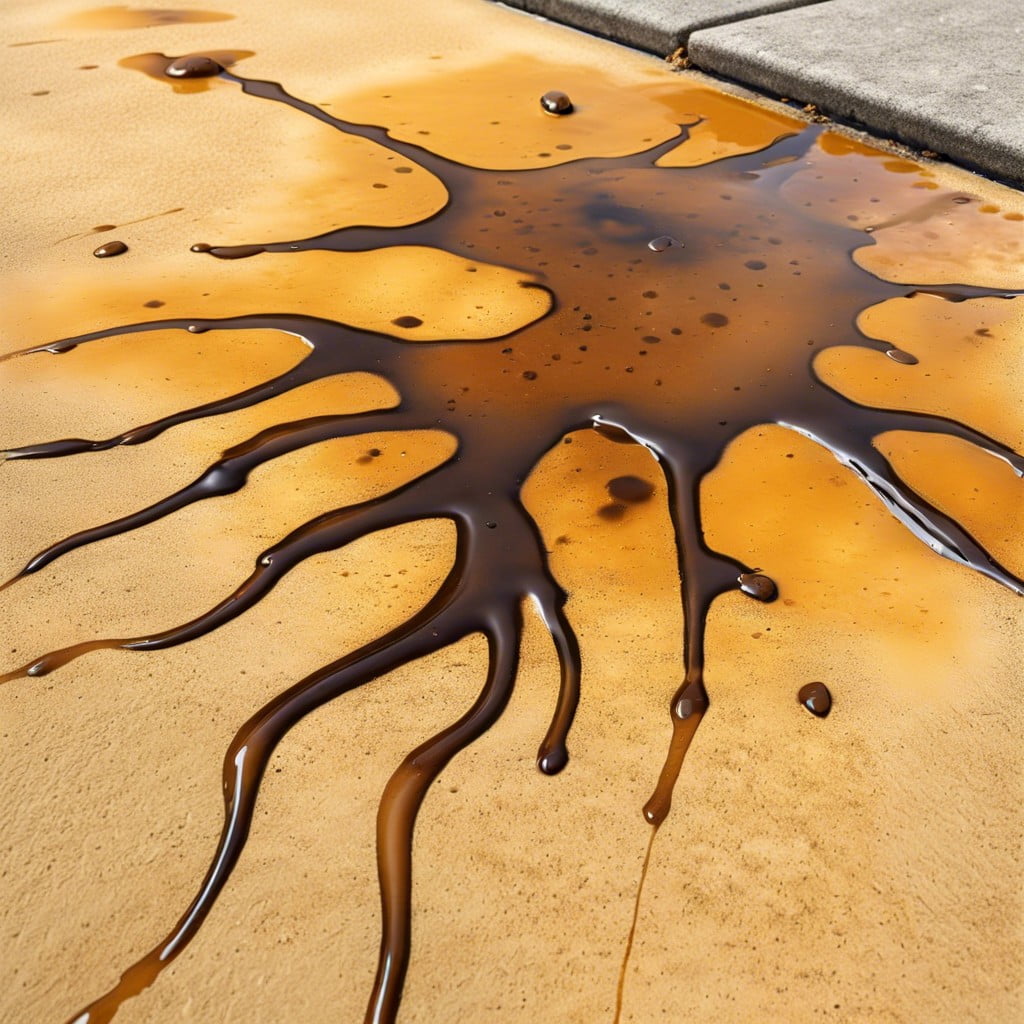Learn how to effectively remove oil stains from concrete using practical cleaning techniques and household products.
Key takeaways:
- Wear protective gloves and eyewear when removing oil stains.
- Assess the size and age of the stain to choose the right cleaning method.
- Use absorbent materials like cat litter or baking soda to remove fresh oil stains.
- Commercial degreasers or a paste of baking soda and acetone are effective for stubborn stains.
- Prevent future oil stains by using a sealer, using drip pans or absorbent mats, cleaning your car regularly, and fixing leaks promptly.
Before Getting Started

Safety comes first. Before diving into the removal process, gather protective gloves and eyewear. Harsh cleaning agents can damage skin and eyes.
Second, assess the stain’s size and age. This information directs the appropriate cleaning method and product choice.
Ensure you have the right cleaning agents on hand. Common household items like baking soda and dish soap can tackle fresh stains, while commercial degreasers are better for stubborn, older marks.
Lastly, prepare the surrounding area. Remove any items that might obstruct your workspace, and protect adjacent landscaping or surfaces that could be harmed by the cleaning products. Clearing the stage sets you up for a streamlined and efficient cleaning experience.
Identifying the Type of Oil Stain
First off, giving your stain the once-over can save you a world of scrubbing. If that dark patch is fresh, you’re likely dealing with a surface spill—think vegetable oil from last night’s barbecue. But if it’s been hanging around a while, settled deep into the concrete, that’s another beast. It might be motor oil that’s had a chance to cozy into the pores.
Take a gander at the stain’s edges. A fresh one will have defined borders, clear as day. But an old faithful will blur the lines, literally, as it seeps further afield. Also, if it’s a deeper hue in the center and lighter around the sides, it’s probably been there longer than your last haircut.
Smell can also be a tell. Yep, get down there and take a whiff. Engine oil carries a mechanical scent, quite the contrast to the kitchen oils that might remind you of frying up Sunday’s bacon. Knowing what you’re up against helps pick your cleaning arsenal; you wouldn’t bring a spoon to a swordfight, after all.
Removing Fresh Oil Stains From Concrete
Time is of the essence with fresh spills; quick action can prevent a permanent shadow on your concrete. Start by blotting up as much oil as you can with paper towels or rags; avoid spreading the stain further.
Next, cover the area with an absorbent material like cat litter, baking soda, or cornstarch. These household powders act like little sponges, soaking up the grease. Give it time to work its magic — a few hours should do.
After the wait, sweep up the saturated absorbent. For any remaining residue, a squirt of dish soap combined with hot water can break down the oil’s stubborn streak. Scrub with a stiff brush to get into the concrete’s nooks and crannies, then rinse away your troubles with a hose. If a ghost of the stain lingers, repeating the soap scrub may show it the door.
By acting swiftly and using these simple steps, you’ll have a clean, spotless surface to be proud of once again. Remember, the faster you tackle the spill, the better your chances of saying goodbye to that stain for good.
The Best Oil Stain Remover for Exterior Concrete
Commercial degreasers can pack a punch when it comes to banishing stubborn oil stains. They plunge deep into concrete’s porous surface to emulsify and lift oil, making cleanup a breeze.
For a cost-effective and eco-friendly option, consider making a paste of baking soda and acetone. Slather this over the stain; the baking soda absorbs while the acetone breaks down the oil. After some patience and elbow grease, rinse away with a high-powered nozzle on your garden hose.
A third alternative would be a poultice, which involves applying a strong absorbing material like clay and letting it sit over the stain. This draws out the oil, potentially saving your driveway from an unsightly blemish.
Keep in mind, efficiency varies. For older or larger stains, repeating the process or letting the treatment sit longer may be necessary. And remember, the sooner you tackle these pesky stains, the better your odds of winning the battle against blemishes on your beloved concrete.
Tips to Prevent Future Oil Stains On Driveways
Kiss oil stains goodbye with these practical driveway defense tips. Apply a high-quality sealer. It’s like an invisible shield for your concrete and makes future stain removal a breeze. Stick to resealing every couple of years, and your driveway stays looking sharp. Park your car like a pro—use drip pans or absorbent mats if you suspect leaks. They catch the oil before it plays its dirty game. Some spots are natural oil magnets, admit it. High-traffic zones deserve extra protection with specially designed mats that lay flat and dare any oil to sneak by.
Cleaning your car regularly isn’t just about shining; it’s about preventative maintenance. A spotless engine bay can spot trouble early, keeping oil on the inside, not the driveway. And for those surprise spills, keep kitty litter or sawdust handy. They’re not just for pets or carpenters; they’ll sop up oil faster than a sponge in a rainstorm. Finally, make it a habit to inspect your vehicle for leaks and fix them pronto. It’s a win-win—your driveway stays pristine, and your car stays in top-notch shape.